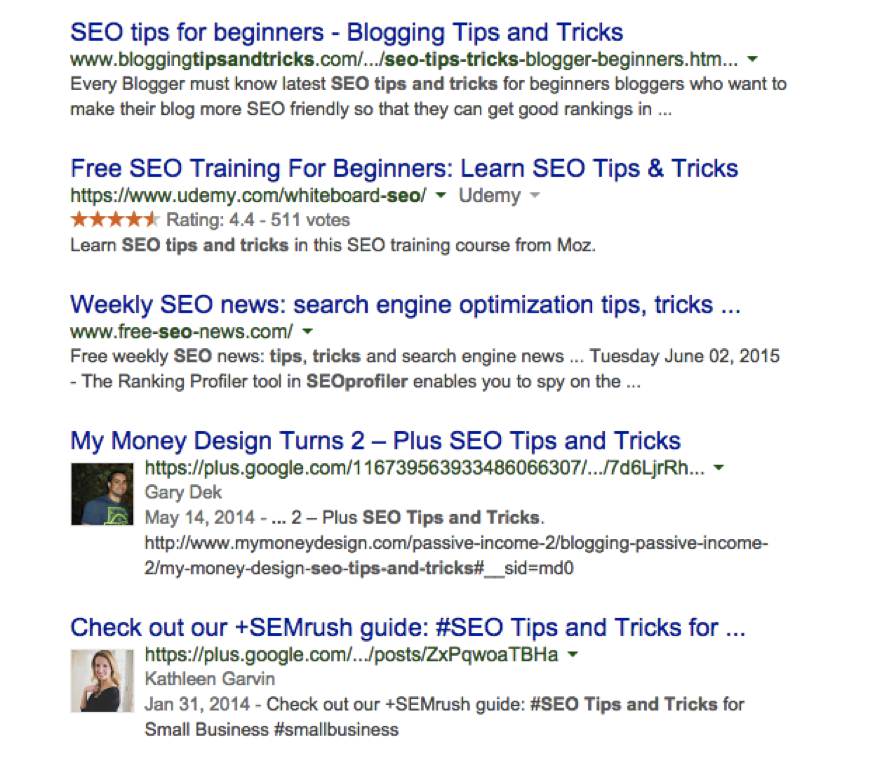If you’re looking to ramp up your SEO efforts once you have the basics down, rich snippets is an excellent next step. For those who are unfamiliar, rich snippets are small add-ons that will help your website jump off a SERP. It allows searches to see information such as reviews and ratings, videos, pictures of a product, and more without even having to click your link. The goal, however, is to draw searchers into your website and get them to click the link because you’re giving them a preview right away; thus setting yourself apart form the competition and the other results on the page. Below is a screenshot of an example SERP:
As you can see, there are a few entries that jump off the page because they offer more information. These are called rich snippets, and how you install rich snippets onto your site is actually quite easy. If you can make sure you setup rich snippets correctly, your CTR as well as your overall SEO rate will improve.
Different Types of Rich Snippets
There are several different types of rich snippets you can use. It’s not necessary to install all of the rich snippets available, but it’s important to know they’re out there so you can make the decisions about which to use based on your specific company:
Products and offers
This is a great option for ecommerce companies because it allows you to mark up things like price and availability. If your product is on sale or you have some sort of limited time offer then you can use this rich snippet to create a sense of urgency. Currently Google does not allow pictures for organic results with rich snippets so this option doesn’t make your result jump off the page quite as much, but it does still offer extra links that other results may not have:
Reviews
Reviews are one of the most popular types of rich snippets, but again these are more popular for ecommerce websites. According to a Practical Ecommerce article, an individual review is marked up using Reviews tagging, but the aggregate of all ratings and reviews—3.5 stars out of 5 over 50 reviews—is considered Reviews Aggregate. Commonly used properties are Item, Rating, and Count. Keep in mind you won’t always see reviews and ratings like in the screenshot below, and sometimes you’ll see Yelp or TripAdvisor reviews only if you’re looking at a result from one of those websites. This snippet comes in all different forms.
Video
These rich snippets simply show you a small thumbnail of the video that you will be taken to if you click on the link or on the video itself (in other words, the video doesn’t play for you right on the SERP). In the screenshot below you’ll see that the video is coming from YouTube, and while this is the most popular option you can also include video rich snippets for actual websites.
Recipes
Of course this is not the most popular choice for a rich snippet, but if you have a website or company that has anything to do with food recipes is something you should use immediately. This is probably one of the best rich snippet options because photos go such a long way with this topic. With this rich snippet it may not be that you’ll stand out because of your photo, but you will be out of place if you don’t have one.
Google+ Authors
You may have noticed in the main screenshot above there are two results that have photos of the authors. The reason for this is because those are Google+ posts that were posted by those people. These results are starting to be personalized to the searcher (which in this case was me) so you won’t see this too commonly, but it’s an excellent way to get your face out there. Moral of the story: Those Google+ posts you’re sharing do make a big difference.
You also may remember authorship markup, which was a type of rich snippet that showed a photo of the author and his/her Google+ follower number, but Google removed authorship in June 2014 because they felt it didn’t mesh with their new visual designs. Of course there is still quite a bit of debate as to the real reason, which you can learn more about here. In either case, authorship is a thing of the past so we have to focus more on the rich snippets we have left.
There are also a few very specialized types of rich snippets such as events and music, which you can check out here if that’s applicable to your company.
Getting Started with Rich Snippets and SEO Considerations
As discussed above, rich snippets’ main benefit is helping your result stand out on a SERP; therefore improving CTR and helping you gain more visibility with Google. It shows that you care about your user and will help you improve your reputation online, so the SEO benefits should spiral once you’ve had rich snippets installed for several months.
Getting started with rich snippets can seem a little bit confusing if you’re not a developer. What you have to do is use a markup called structured data or Schema.org. You can learn the technical process for setting up rich snippets for Google here. For developers, it should only take a few minutes to get going!
Any questions? Let us know in the comment section below.






